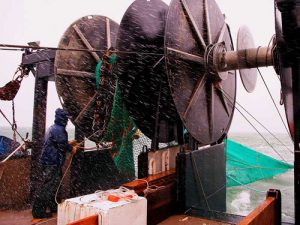 NOAA Fisheries is initiating a planning process to support its intention to transition part or all of the Northeast Fisheries Science Center’s spring and fall bottom trawl surveys from the NOAA Ship Henry B. Bigelow to fishing industry vessels provided that survey data collection quality and time series integrity can be maintained.
NOAA Fisheries is initiating a planning process to support its intention to transition part or all of the Northeast Fisheries Science Center’s spring and fall bottom trawl surveys from the NOAA Ship Henry B. Bigelow to fishing industry vessels provided that survey data collection quality and time series integrity can be maintained.
“The bottom trawl survey is perhaps the most valuable ecological data set that we maintain at the Center,” said Bill Karp, the center’s director. “Those data are critical for many of the fishery stock assessments in the region and are mined by a wide variety of researchers for other purposes. By sharing the responsibility for gathering these data with the fishing industry, I think there will also come greater shared confidence in the results obtained using them.”
A typical survey covers about 400 stations off the Northeastern U.S. in the Gulf of Maine, on Georges Bank, and south to Cape Hatteras. The scientific trawl is towed to collect marine species, while a variety of environmental and oceanographic data are also being collected.
Biological samples are taken from trawled animals for a variety of studies and to calculate an index of catch per tow by species. The resulting data are used to study everything from food habits to habitat use and the effects of climate change.
The target timeframe for the transition is five years. A science center working group is being established to develop options and criteria for making the shift. They will work closely with industry during this process through the Northeast Trawl Survey Advisory Panel, convened jointly by the Mid-Atlantic Fishery Management Council, the New England Fishery Management Council, and the Atlantic States Marine Fisheries Commission.
The NEFSC bottom trawl survey is the longest-running of its kind in the world. The first trip was in May 1963, and since then seasonal surveys have been conducted annually. The surveys are conducted from government research vessels operated by NOAA and predecessor agencies.
source: NOAA Fisheries Service